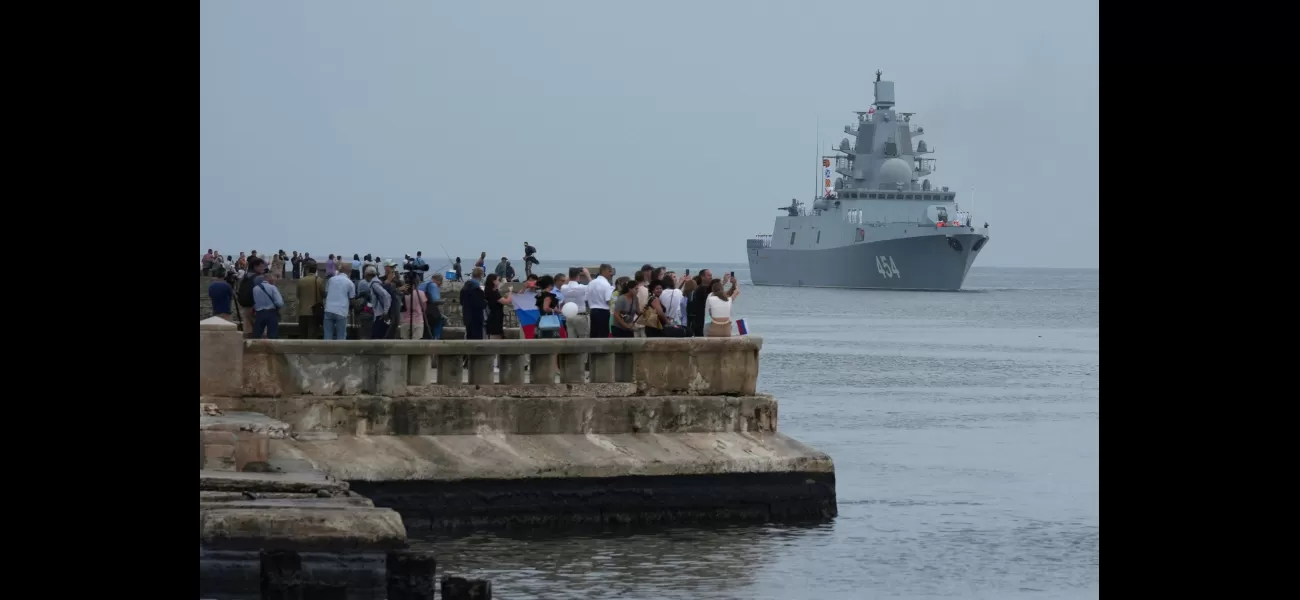Russian naval vessels dock near President Biden's residence, reigniting worries of a return to Cold War tensions.
In 1962, the Cuban missile crisis was a major event where the US and Soviet Union almost went to war over nuclear weapons.
June 12th 2024.

This week, the Admiral Gorshkov, a Russian warship under the command of Vladimir Putin, made its way into Havana, Cuba. The arrival of these vessels on Joe Biden's doorstep has raised concerns and sparked fears of a potential global conflict. The scene is eerily reminiscent of the Cuban Missile Crisis, with a fleet of Russian ships arriving in the Caribbean just before planned military exercises.
The timing of this mission has been seen as yet another attempt by President Putin to showcase his military might and gain support for his ongoing war in Ukraine. Among the four vessels that crossed the mouth of Havana Bay on Wednesday were a nuclear submarine and a naval frigate. While US officials have stated that they do not see this as a direct threat, they are closely monitoring the situation.
This visit to Cuba comes just weeks after Putin's meeting with Cuban President Miguel Diaz-Canel in Moscow. In addition to the Admiral Gorshkov, a nuclear-powered submarine also made the journey to Cuba. It is expected that the military drills will involve a small number of Russian ships and support vessels, with possible stops in Venezuela. Russia has long been an ally of both Venezuela and Cuba, and their warships and aircraft have made occasional appearances in the Caribbean.
The timing of this mission is particularly notable as it comes on the heels of President Biden lifting an embargo that allowed Ukraine to use US-provided weapons for protection against Russian attacks. In response, Putin issued a warning that his military could take "asymmetrical steps" in other parts of the world. According to Benjamin Gedan, director of the Latin America Program at the Wilson Center, this is a reminder to the US that it is unpleasant when an adversary interferes in your own region. It also serves as a reminder to US rivals like Cuba and Venezuela that Russia is on their side.
American officials have stated that Russia's deployment does not pose a direct threat to the US, but they will be closely monitoring the situation. It is expected that the Russian ships will remain in the region throughout the summer. On shore, Cubans have been seen proudly waving Russian flags, a symbol of the long-standing relationship between the two countries.
This is not the first time Russian ships have made their way to Cuba. In 2008, a group of Russian vessels entered Cuban waters, marking the first visit in nearly two decades. Just last week, Russian Foreign Minister Sergei Lavrov met with his Cuban counterpart, Bruno Rodriguez, for talks in Moscow.
While some experts see this as a mere act of provocation, others believe it is a demonstration of Russia's ability to project power into the Western Hemisphere with the help of its allies. Ryan Berg, director of the Americas Program at the Center for Strategic and International Studies, believes that this presence will keep the US military on high alert while the Russian ships are in the region.
The Cuban Missile Crisis in 1962 is often cited as the closest the world has ever come to a nuclear war between the US and the Soviet Union. This recent visit by Russian ships to Cuba serves as a reminder of that tense time and the potential for conflict between these two superpowers. As tensions continue to rise, the world watches and holds its breath, hoping for a peaceful resolution.
The timing of this mission has been seen as yet another attempt by President Putin to showcase his military might and gain support for his ongoing war in Ukraine. Among the four vessels that crossed the mouth of Havana Bay on Wednesday were a nuclear submarine and a naval frigate. While US officials have stated that they do not see this as a direct threat, they are closely monitoring the situation.
This visit to Cuba comes just weeks after Putin's meeting with Cuban President Miguel Diaz-Canel in Moscow. In addition to the Admiral Gorshkov, a nuclear-powered submarine also made the journey to Cuba. It is expected that the military drills will involve a small number of Russian ships and support vessels, with possible stops in Venezuela. Russia has long been an ally of both Venezuela and Cuba, and their warships and aircraft have made occasional appearances in the Caribbean.
The timing of this mission is particularly notable as it comes on the heels of President Biden lifting an embargo that allowed Ukraine to use US-provided weapons for protection against Russian attacks. In response, Putin issued a warning that his military could take "asymmetrical steps" in other parts of the world. According to Benjamin Gedan, director of the Latin America Program at the Wilson Center, this is a reminder to the US that it is unpleasant when an adversary interferes in your own region. It also serves as a reminder to US rivals like Cuba and Venezuela that Russia is on their side.
American officials have stated that Russia's deployment does not pose a direct threat to the US, but they will be closely monitoring the situation. It is expected that the Russian ships will remain in the region throughout the summer. On shore, Cubans have been seen proudly waving Russian flags, a symbol of the long-standing relationship between the two countries.
This is not the first time Russian ships have made their way to Cuba. In 2008, a group of Russian vessels entered Cuban waters, marking the first visit in nearly two decades. Just last week, Russian Foreign Minister Sergei Lavrov met with his Cuban counterpart, Bruno Rodriguez, for talks in Moscow.
While some experts see this as a mere act of provocation, others believe it is a demonstration of Russia's ability to project power into the Western Hemisphere with the help of its allies. Ryan Berg, director of the Americas Program at the Center for Strategic and International Studies, believes that this presence will keep the US military on high alert while the Russian ships are in the region.
The Cuban Missile Crisis in 1962 is often cited as the closest the world has ever come to a nuclear war between the US and the Soviet Union. This recent visit by Russian ships to Cuba serves as a reminder of that tense time and the potential for conflict between these two superpowers. As tensions continue to rise, the world watches and holds its breath, hoping for a peaceful resolution.
[This article has been trending online recently and has been generated with AI. Your feed is customized.]
[Generative AI is experimental.]
0
0
Submit Comment





